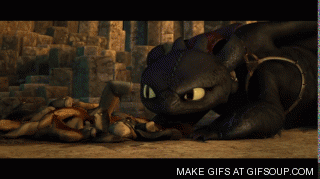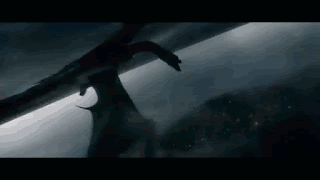While I'm animating a dragon, mostly inspired by real life references such as bats and bears, I thought I'd take a blog post to talk about how dragons have appeared in movies, video games and tv shows. This is because I want to talk about dragons and it gives me an excuse to watch films with dragons in.
To start off with, I'm going to talk about a film series: How to Train Your Dragon.
Produced by Dreamworks, however this isn't Dreamworks first time animating a dragon. In 2001, Dreamworks produced the masterpiece that is Shrek.
In Shrek, it appears that for the most part, the dragon moved somewhat similar to Donkey, with no real noticeable reference to anything. However, Shrek is still a fantastic movie, albeit one I won't be going to for dragon reference.
Perhaps due to dragons having more significance in the plot of How to Train Your Dragon, a lot more thought was put into the dragons and their movement. Throughout the film we have movements similar to how cats move as well as dogs. However, one part I took interest in especially was the flight.
Here we can see that the flight is somewhat bat like, with the wing curling inwards as it is brought towards the body and upwards. However, unlike a bat, the wings, on all of the dragons, only flap a few times before stretching out to glide. This kind of flight is seen in another film series, The Hobbit.
Here we can see a shot from HBO's Game of Thrones, where the same sort of flying is achieved. Lots of gliding is going on.
One of the earliest films to have 3D dragon animation was Dragonheart, while the dragon animations aren't quite the polish we'd expect nowadays, they are still definitely enjoyable and have their own merit. Yet again, the same idea of a few flaps and gliding is employed however.
Yet again, the same flight style is used in the Harry Potter film series.
And in the Spyro video games...
The video game World of Warcraft cycles between either flapping or gliding with every winged dragon, so is yet again, basically the same method of flight.
We can see from this that it's apparently generally agreed that dragons all fly in this manner. Now, while this does make sense, massive creatures would take a lot of energy to be flapping constantly, it would make sense that they would try to move as much air with as little effort, hence why realistic styled dragons, like Smaug, are stylised to have such large wingspans. Now, while the general movement of wings are very similar across all dragons that I've talked about here, they aren't all the same. A lot of the dragon animations, especially the more realistic and detailed animations, have different ligaments along the wing bending when flapping, as well as having slight adjustments when gliding.
From this research, it seems apparent that along with flapping animations, I will also need to do at least a gliding animation, however if I have time, I would also like to experiment with other animations to see what other flying animations I can create that are unique without looking unnatural.
We can see from this that it's apparently generally agreed that dragons all fly in this manner. Now, while this does make sense, massive creatures would take a lot of energy to be flapping constantly, it would make sense that they would try to move as much air with as little effort, hence why realistic styled dragons, like Smaug, are stylised to have such large wingspans. Now, while the general movement of wings are very similar across all dragons that I've talked about here, they aren't all the same. A lot of the dragon animations, especially the more realistic and detailed animations, have different ligaments along the wing bending when flapping, as well as having slight adjustments when gliding.
From this research, it seems apparent that along with flapping animations, I will also need to do at least a gliding animation, however if I have time, I would also like to experiment with other animations to see what other flying animations I can create that are unique without looking unnatural.










No comments:
Post a Comment